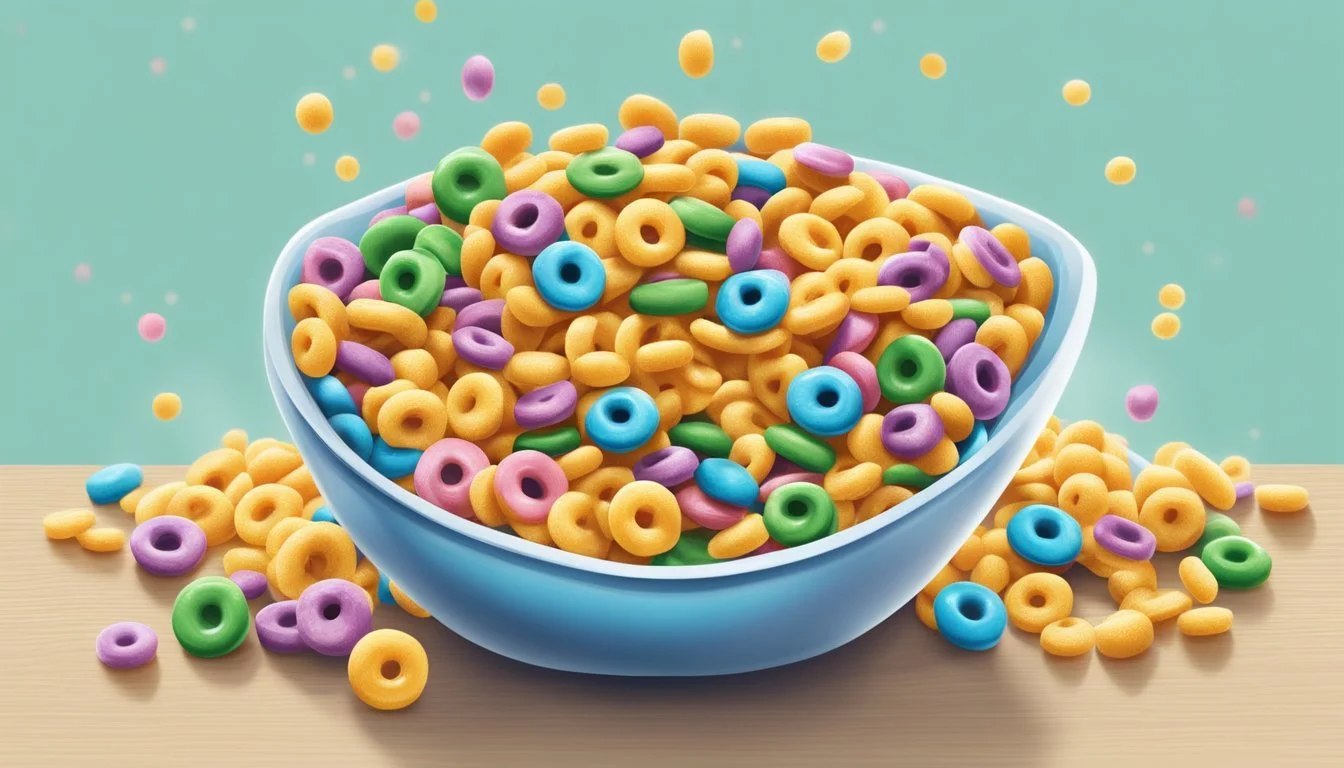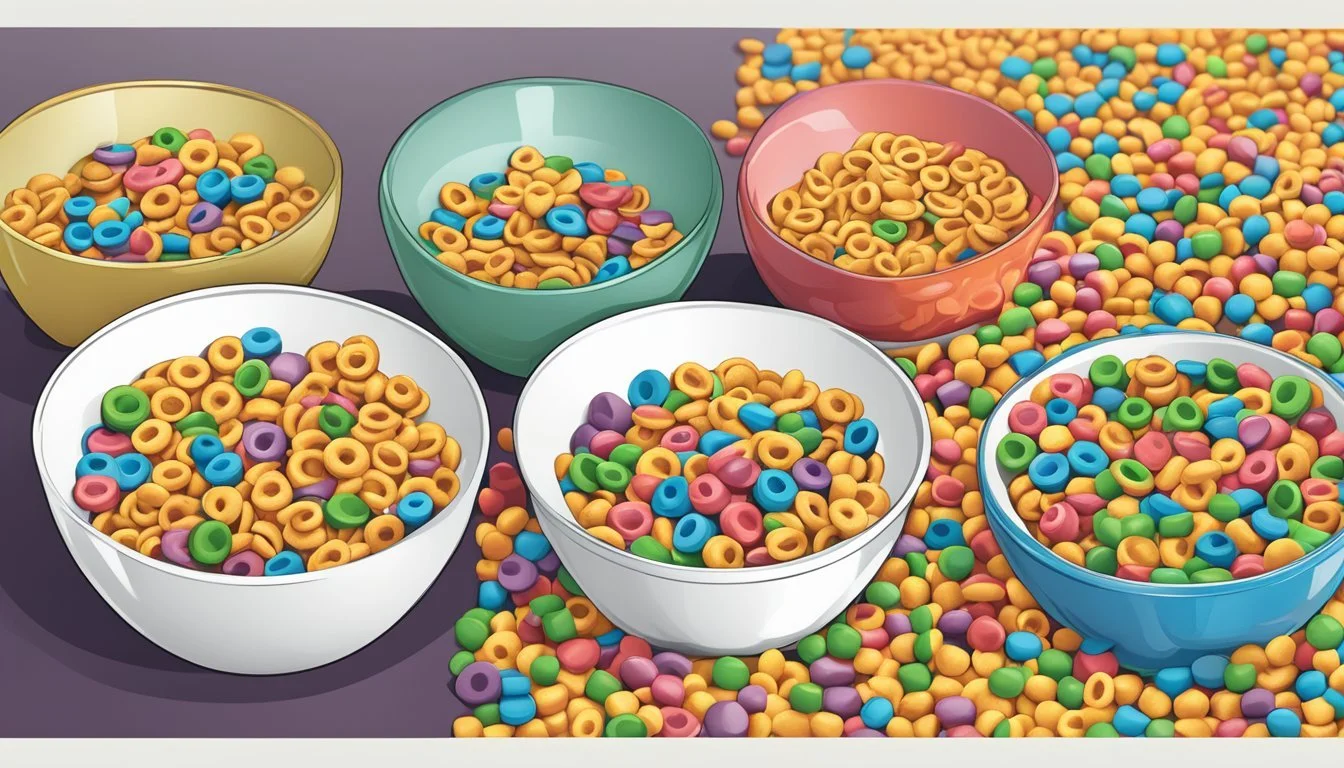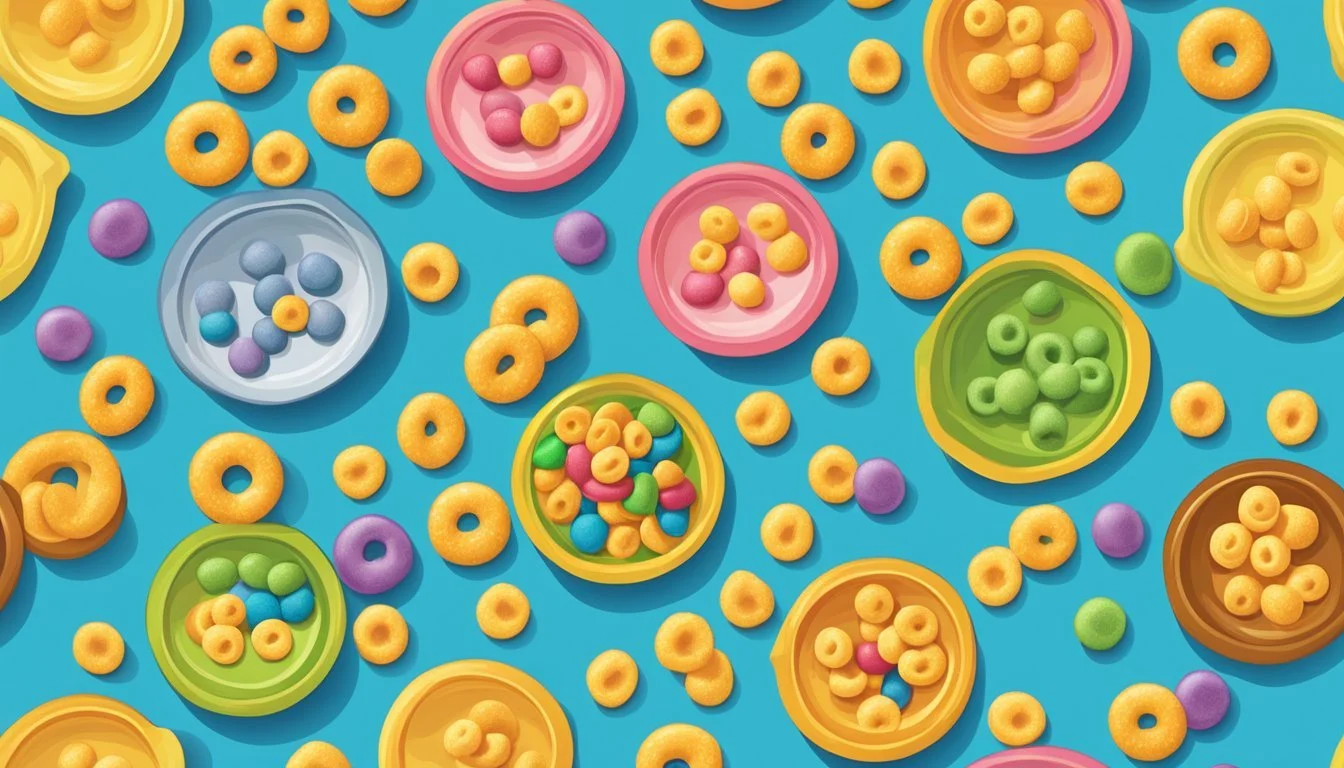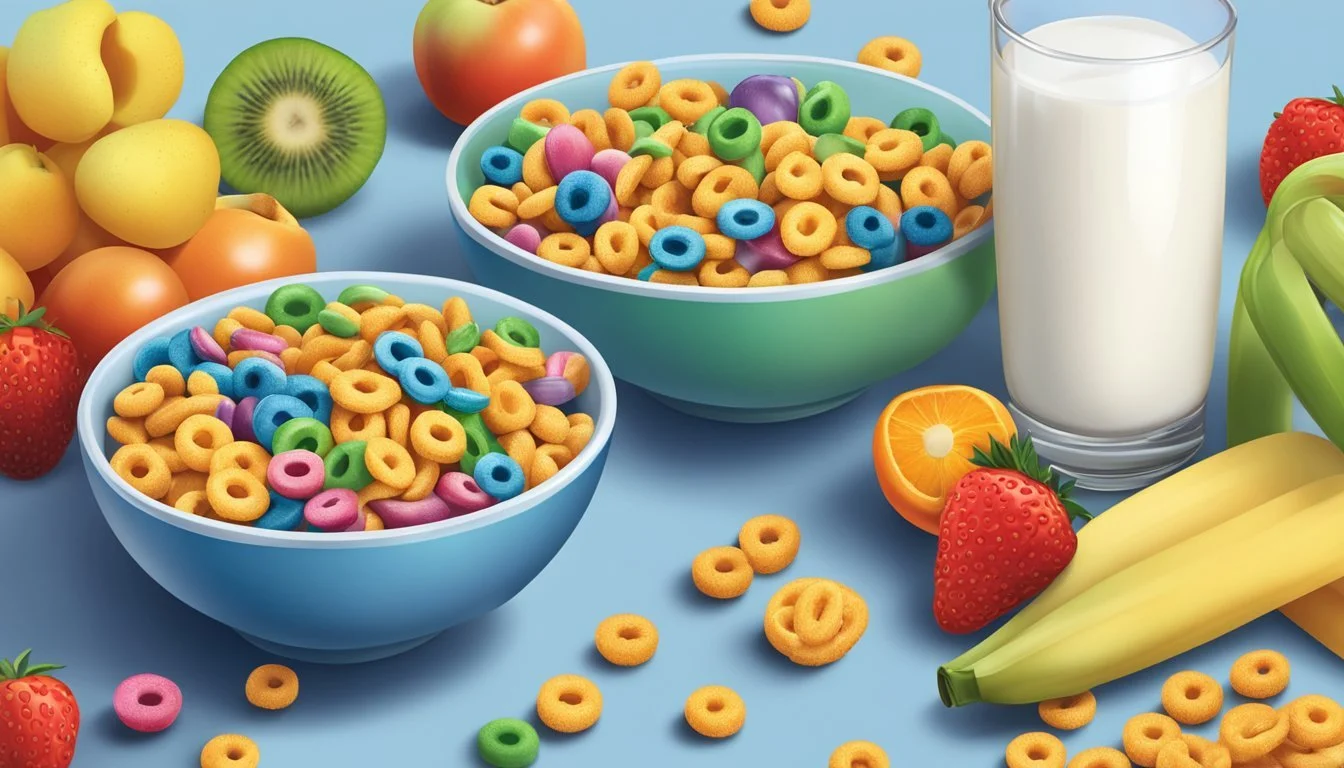Cheerios vs Trix
Nutritional Comparison and Taste Test
This Article is Part of Our Breakfast Cereal Guide with Details on Cheerios Nutrition and Trix Nutrition
When it comes to choosing a nutritious and delicious breakfast cereal, the debate often hovers over two iconic brands: Cheerios and Trix. Both produced by General Mills, these cereals cater to different tastes and nutritional needs. Cheerios are typically praised for their higher content of complex carbohydrates and fiber, making them a strong contender for those looking to start their day on a healthier note.
Trix, on the other hand, appeals more to children and those with a sweet tooth, given its vibrant colors and fruity flavors. While this cereal offers a fun and engaging breakfast option, it tends to have a higher sugar content compared to Cheerios. This makes Trix a less favorable option for those seeking a lower-sugar diet.
Whether you're drawn to the heart-healthy reputation of General Mills Cheerios or the playful, flavor-packed experience of General Mills Trix, understanding the nutritional differences can help you make an informed choice. Dive deeper into this comparison to find out which cereal aligns best with your dietary goals and taste preferences.
History and Development
Cheerios and Trix are both iconic cereals produced by General Mills. Each has a unique history, evolving from their initial creation to become mainstays in the cereal market.
Origins of Cheerios
Cheerios, introduced by General Mills in 1941, were originally called "Cheerioats." The name changed to Cheerios in 1945. Developed as a new way to consume oats, the cereal quickly gained popularity.
Honey Nut Cheerios, introduced in 1979, became one of the top-selling cereals. General Mills wanted to diversify the Cheerios brand, which now includes various flavors like Apple Cinnamon and Multigrain.
General Mills positioned Cheerios as a heart-healthy option, reinforced by its soluble fiber content and simple ingredients.
Evolution of Trix
Trix, also from General Mills, debuted in 1954. It was marketed as a fruity and colorful cereal aimed at children. The well-known slogan "Silly Rabbit, Trix are for Kids!" and the Trix Rabbit mascot became synonymous with the brand.
Initially, Trix was a simple, round cereal but changed to a fruit shape in 1991. Due to customer demand, General Mills reverted back to the original shapes in 2007.
Trix has expanded its range over the years, including varieties like Trix Swirls and Trix Yogurt, maintaining its appeal among children with vibrant colors and fun shapes.
Nutritional Profiles
General Mills Cheerios and General Mills Trix offer distinct nutritional benefits. The differences in macronutrients, vitamins, and calories can help guide consumers in making healthier breakfast choices.
Macronutrient Comparison
Cheerios contain more complex carbohydrates than Trix, with 17 grams per serving compared to Trix's 13 grams. Protein content in Cheerios is higher at 2 grams per serving, while Trix has 1 gram per serving. Cheerios have lower fat content, at 1 gram of fat per serving, as opposed to Trix's higher fat content.
Macronutrient Table:
Nutrient Cheerios Trix Protein (g) 2 1 Complex Carbs (g) 17 13 Fat (g) 1 1
Vitamin and Mineral Content
Cheerios provide superior iron coverage, offering 204% of the daily need, while Trix's iron content is not highlighted prominently. In terms of selenium, Cheerios contain 24.9µg per serving, whereas Trix delivers 6.5µg. Cheerios fall short in Vitamin B2, containing 0.1mg compared to Trix's 1.89mg.
Vitamin and Mineral Table:
Vitamin/Mineral Cheerios Trix Iron (%) 204% - Selenium (µg) 24.9 6.5 Vitamin B2 (mg) 0.1 1.89
Caloric Values
Caloric intake per serving is a considerable difference. Cheerios offer a generally lower calorie option, though the exact measurement isn't specified. Trix contains 110 calories per serving. This can be pivotal for those monitoring calorie consumption as part of their dietary goals.
Caloric Values Table:
Cereal Calories per Serving Cheerios Not specified Trix 110
Cheerios and Trix vary significantly in different nutritional aspects, informing individual preferences and dietary decisions.
Taste and Texture
Cheerios and Trix present distinct experiences in terms of taste and texture that cater to different preferences. Each cereal offers unique flavor profiles and textural elements worth exploring.
Flavor Profiles
Cheerios generally have a wholesome and subtly sweet taste. The original variety is known for its mild oat flavor, which can be slightly nutty. Variants such as Honey Nut Cheerios bring in additional sweetness with a touch of honey, enhancing its overall appeal. Other flavors range from the fruity notes of Multi-Grain Cheerios to the chocolatey tones of Chocolate Cheerios.
Trix offers a vibrant and sugary taste that is both fruity and bold. Each bite delivers a burst of artificial fruit flavors, reminiscent of other cereals like Fruity Pebbles. This makes Trix a favorite among those who prefer a more pronounced and sugary flavor profile. Trix does not shy away from its candy-like taste, catering specifically to children and those with a sweet tooth.
Texture Analysis
Cheerios have a light, crisp texture that holds its shape well in milk. The O-shaped pieces offer a satisfying crunch initially, but they soften relatively quickly when submerged. This balance between crunch and softness can make Cheerios versatile, appealing to both those who prefer crunchier cereals and those who like a softer texture after a few minutes in milk.
Trix features small, puffed pieces that are firm and crunchy. The texture is consistent and remains relatively crunchy even after soaking in milk. This persistent crunchiness contrasts with cereals like Cocoa Puffs, which tend to get soggy faster. Trix's texture, alongside its bold flavors, makes it a robust option for those who like their cereal to retain a bit of bite throughout the eating experience.
Brand Diversification
Cheerios and Trix have expanded through various spin-offs and flavors to keep up with consumer trends and preferences. These diversifications showcase how each brand adapts to market demands.
Cheerios Varieties
Cheerios, produced by General Mills, offers a wide range of varieties to cater to different tastes and health needs.
Some popular Cheerios varieties include Honey Nut Cheerios, known for its blend of honey and nuts, and Apple Cinnamon Cheerios, which combines real apples and cinnamon. Each of these flavors aims to provide additional nutritional benefits and taste profiles.
Multi-Grain Cheerios is another notable variety, offering a blend of five whole grains. This variety is marketed as a high-fiber, low-sugar option. Cheerios Protein and Gluten-Free Cheerios cater to specific dietary needs, with added protein or gluten-free ingredients.
Flavor Varieties:
Honey Nut Cheerios
Apple Cinnamon Cheerios
Multi-Grain Cheerios
Cheerios Protein
Gluten-Free Cheerios
Trix Spin-offs
Trix cereals, also manufactured by General Mills, have created several spin-offs to maintain its appeal, especially among children.
Trix has introduced variations such as Trix Yogurt, which combines the colorful and sweet cereal flavors with yogurt. This product provides a different texture and additional nutritional benefits.
Trix with Marshmallows is another notable variant, blending the traditional fruity cereal with marshmallow pieces to attract kids who enjoy sweeter breakfast options. These variations maintain the iconic fruit shapes and vibrant colors that have made Trix popular.
New Varieties:
Trix Yogurt
Trix with Marshmallows
Trix Minis
Each of these spin-offs allows Trix to reach different market segments while staying true to its core identity.
Health and Diet Considerations
When choosing between Cheerios and Trix, it is essential to consider various health and dietary aspects. This section focuses on sugar content, dietary fiber, and how each cereal fits into a balanced diet.
Guidelines for Low-Sugar Diet
Cheerios is typically lower in sugar compared to Trix. For example, Multi-Grain Cheerios contains 6 grams of sugars per serving. In contrast, Trix has 12 grams of sugars per serving. Reducing sugar intake is crucial for managing weight and preventing chronic diseases.
A low-sugar diet helps maintain stable blood glucose levels, making Cheerios a better choice for those monitoring their sugar consumption.
Cereal Sugars per Serving Cheerios 6 grams Trix 12 grams
Individuals following a low-sugar diet may benefit from opting for Cheerios, which aligns more closely with dietary recommendations.
Dietary Fiber Focus
Dietary fiber is vital for digestive health and can aid in lowering cholesterol levels. Multi-Grain Cheerios provides 2.0 grams of dietary fiber per serving, while Trix offers none.
Higher fiber content makes Cheerios a better option for those looking to increase their fiber intake. The FDA recommends a daily fiber intake of 28 grams for a 2,000-calorie diet.
Cereal Dietary Fiber per Serving Multi-Grain Cheerios 2.0 grams Trix 0.0 grams
Choosing cereals like Cheerios with higher fiber can contribute to better overall digestive health.
Cereal in Balanced Diet
Cheerios provides additional nutrients that can support a balanced diet. For example, it is higher in certain vitamins and minerals such as iron and selenium. Cheerios' daily need coverage for iron is 204% higher than that of Trix.
Both cereals have low-fat content, making them suitable for low-fat diets.
To achieve a balanced diet, consider pairing Cheerios with other nutrient-rich foods. This can include fruits, low-fat dairy, or nuts, enhancing the overall nutritional profile of your meal.
Incorporating Cheerios into a balanced diet can contribute positively to health goals, especially for those mindful of their sugar and fiber intake.
Consumer Information
Understanding the price and availability of Cheerios and Trix is crucial for consumers to make informed decisions. Below, important details regarding the cost and accessibility of both cereals are highlighted.
Price Consideration
When comparing Cheerios and Trix, the cost is a significant factor. Typically, Cheerios, produced by General Mills, can be found at an average price range of $2.50 to $4.00 per box, depending on the variant and retailer. Trix, also manufactured by General Mills, often falls in a similar price bracket, averaging between $2.00 to $3.50 per box.
Special offers and discounts are common for both cereals, especially in larger chain supermarkets. Consumers may also purchase these cereals in bulk for reduced prices at wholesale clubs. It is advisable to check for coupons and store promotions to save money. Both cereals may also be included in loyalty programs offered by various retailers, providing additional savings opportunities.
Availability and Accessibility
Cheerios and Trix are widely available across the United States. Both cereals can be found in most grocery stores, supermarkets, and online platforms. General Mills ensures that these products are well-stocked in popular chains such as Walmart, Target, and Kroger, making them easily accessible to a broad audience.
Online availability has expanded significantly, with platforms like Amazon, Walmart's online store, and Instacart carrying extensive inventories of both cereals. This means that consumers can conveniently purchase Cheerios and Trix without leaving their homes.
Varied sizes, from single-serving packs to family-sized boxes, cater to different needs and preferences, enhancing the accessibility and convenience of purchasing these cereals.
Environmental and Ethical Impact
Both Cheerios and Trix aim to address environmental sustainability and corporate responsibility. General Mills, the parent company for both cereals, has been involved in various initiatives to ensure they are environmentally friendly and ethically responsible.
Sustainable Practices
General Mills has implemented several measures to reduce the environmental impact of their cereal production. Cheerios is often highlighted for its use of whole grains, which typically require fewer resources to grow compared to processed grains. Additionally, there is a focus on reducing packaging waste and utilizing recyclable materials.
General Mills has also invested in agricultural practices that promote soil health and reduce water usage. These sustainable practices are a cornerstone of their commitment to minimizing the environmental footprint of their products.
Corporate Responsibilities
General Mills emphasizes ethical responsibilities through various community and global initiatives. They have committed to sourcing ingredients in a sustainable and ethical manner, which includes obtaining grains and other raw materials from suppliers that follow fair labor practices.
Programs aimed at improving biodiversity and reducing pesticide use are also in place. Notably, the detection of chlormequat chloride, a plant growth regulator, in some batches of Cheerios has led them to revise their agricultural chemical policies to ensure greater safety and sustainability.
Moreover, General Mills has been transparent about their efforts to address climate change and has set ambitious goals to reduce greenhouse gas emissions across their supply chain.







